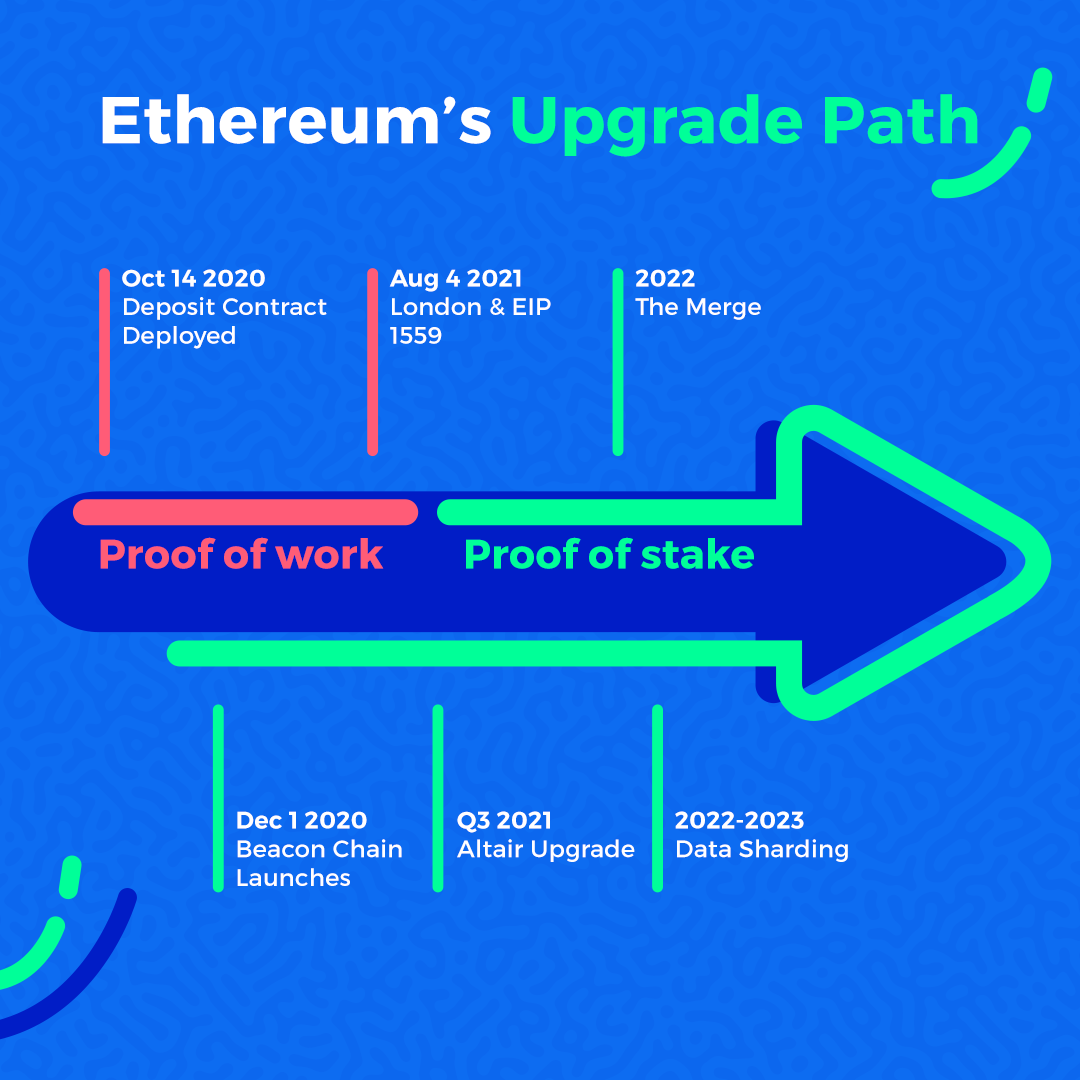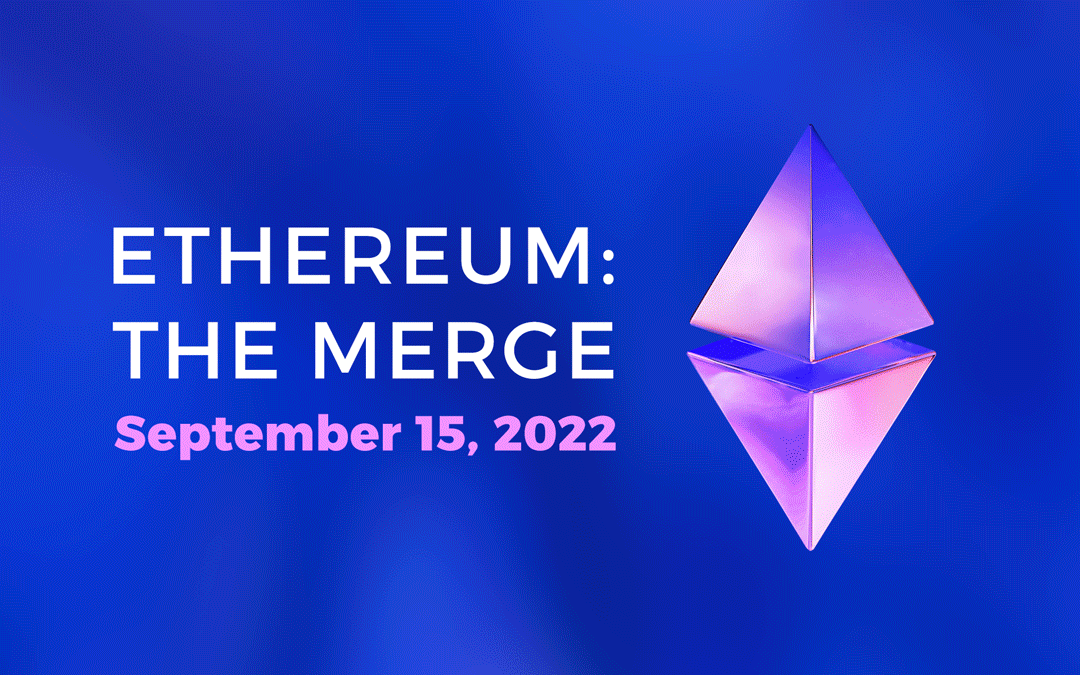For a long time, the Merge has been one of the hottest bones of contention within the crypto industry. It is an upgrade set to take place on the second largest cryptocurrency network, Ethereum. Since 2015, Ethereum has been serving its purpose, housing many decentralized computing platforms. As a result, it supports the launch of many projects on its network.
While maintaining its stand as one of the strongest blockchain networks, its infrastructure can't scale to accommodate the increasing global demand imposed on its network. In order to tackle this problem, the Ethereum developers proposed a set of upgrades. Part of these upgrades includes the Beacon chain and the Merge. In this article, we will talk about the important things you need to know about the Merge.
What Is the Merge All About?
The Merge represents the joining of the existing consensus layer of Ethereum (the mainnet) with the new Beacon chain that uses the proof-of-stake mechanism. In other words, it refers to the combination of the current proof-of-work mechanism with the proof-of-stake mechanism. The Merge is aimed at preparing the network for upcoming upgrades as well as enhancing the security of the network.
After the Merge, the network censorship is expected to change from the current proof-of-work consensus mechanism to the proof-of-stake; meaning that new blocks will be added by validators and not miners.
As a result, it allows validators to secure the network, eliminating the need for an energy-intensive mining process. It is a step towards actualizing the network's vision which is to be more scalable, secure, and sustainable. This exciting event is scheduled to take place on September 15, 2022.

What Is Proof-of-Work (PoW)?
Proof-of-work (PoW) is the first type of consensus mechanism pioneered by the Bitcoin network. It allows new blocks to be added to the network by miners who compete against one another to solve complex computational puzzles. The miners need to be the first to solve the problem using highly powered computers in order to mine a block.
Notably, anyone that successfully does this is rewarded with a preset amount of the cryptocurrency. In this mining process, computers consume vast amounts of energy and as a result, the network is usually slow and congested. Also, the imbalance in the network's transmission favors miners with highly functional equipment. The consensus mechanism is not eco-friendly as large amounts of heat and carbon are released during mining.
What Is Proof-of-Stake?
The proof-of-stake consensus mechanism is the type in which new blocks are added to the network by selecting random nodes called validators. Instead of miners, the validators confirm the transaction and take up the role of creating new blocks to the network. The validators are then rewarded with transaction fee tips and staking rewards for their job in maintaining and keeping the network safe.
To become a validator, you need to pledge a stake of digital currency — in this case, 32 ETH — to function as a node on the network. However, the process is not based on a lottery whereby the more coins you stake, the better your odds of being selected are. Instead, the process is aimed at making the network faster and more secure.
Any validator who tries to trick the system stands the chance to risk all or part of its staked asset or better still, lose its status as a validator. The node is randomly selected periodically to confirm transactions. As a result, validators do not need high computing power. Instead, they use up fewer resources, leaving the greater parts to the network; thereby, making it more sustainable.
Is Proof-of-Stake Better Than Proof-of-Work?
According to the Ethereum Foundation, the introduction of PoS will cut down Ethereum energy usage by ~99.9%. PoS advocates explain that the PoW tends to be difficult to scale as the number of transactions that can be confirmed by each block is limited, making it difficult to mine the blocks at a constant rate.
Though the mechanism is very safe, the block time combined with the block confirmation limits can cause network congestion during an increase in the demand for the network. This congestion often causes a rise in transaction fees and what we know as the "gas war". You can read more here.
The PoW proponents counter that of the PoS consensus in that it carries its own centralisation and censor risk, making it possible for bad actors to directly "buy" the control of the network. Furthermore, they also point out that PoS is a less battle-tested system when compared to PoW which has proven resilient as the backbone of the two largest blockchain networks.
Why Does The Merge Matter?
The Merge is considered by many to be a new milestone in the history of cryptocurrency, due to the philosophical implications and potentials embedded. This will help to boost the network's confidence and inject much-needed optimism in investors. This means participants can become validators even with the use of small computers.
The Merge matters a lot to bolster the scarcity and reduce the network congestion on the Ethereum network. The introduction of PoS will help to reduce the overall supply of Ethereum and make it a deflationary asset. The PoS is designed to provide huge security for the network at the lowest possible cost and by that, helps to reduce the amount of ETH issued to validators to secure the network.
Pre-Merge, the amount of ETH issued to miners as a reward for their contribution to the network is huge. With PoS, the issuance of ETH is drastically reduced by over 90%; thus, making it a deflationary asset. This means that per transaction, instead of simply paying an entire gas fee to the miner, only a few are given to the validator as a reward.
This will help reduce the amount of ETH in the ecosystem because the amount of ETH being burnt is higher than the rate of ETH being issued, causing the supply of ETH to decrease. In addition, a Merge like this is an incredibly rare event in crypto, and may never happen again.
Will It Surge Up The Price of Ether?
Well, it is hard to say.
With so many factors and unknowns to consider, it is impossible to predict the price of Ethereum after the Merge. The Ethereum Foundation has been working actively in the past few years to make this upgrade possible. Apart from solving scalability problems and addressing the environmental implication of the network, it will also attract institutional investors through the introduction of staking to the network.
Staking Ethereum is expected to yield 10-15% annually which is huge compared to the stock reward. As a result, this makes it a strong asset considered by big investors to make huge profits at low risk. Also, as the amount of staked ETH increases, the lower the amount of ETH in the crypto market. This introduces scarcity, resulting in an increase in the value of ETH with increasing demand.
Notably, not everyone is confident or sure whether the Merge will help boost the price of Ethereum. It all depends on individual opinion and proper risk management. Even with that, there are still some risks to be considered including the probability that the Merge will run into hiccups, or that PoS will prove more secure than PoW in the long run.
The Merge’s Impact on Oobit Users
During the Merge, Oobit will temporarily halt Ethereum (ETH), ERC-20, token deposits and withdrawals as a precautionary measure. This downtime allows us to ensure that the transition is successfully reflected by our systems. You will be informed via our social media channels when these tokens are available for deposits and withdrawals.
We recommend that you don't send your ETH to anyone in an attempt to upgrade it to "ETH2 token" as there is no token bearing such name. Also, your asset will be safe and secure during the Merge period and you are required to carry out no action with your ETH during the event.
Oobit Technologies Pte, 50 Raffles Place #37-00 Singapore Land Tower, Singapore (048623). is a company registered in Singapore (no:201716443G), that has been approved as Appointed Representative of Oobit Technologies OÜ, Harju maakond, Tallinn, Lasnamäe linnaosa, Väike-Paala tn 2, 11415, (no: 14852617 ). Which is authorized and regulated by the FIU (no: FVR001421 and FRK001304).
